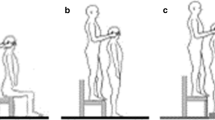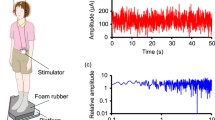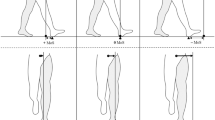Abstract
Vestibular inputs tonically activate the antigravitative leg muscles during normal standing in humans, and visual information and proprioceptive inputs from the legs are very sensitive sensory loops for body sway control. This study investigated the postural control in a homogeneous population of 50 unilateral vestibular-deficient patients (Ménière’s disease patients). It analyzed the postural deficits of the patients before and after surgical treatment (unilateral vestibular neurotomy) of their diseases and it focused on the visual contribution to the fine regulation of body sway. Static posturographic recordings on a stable force-plate were done with patients with eyes open (EO) and eyes closed (EC). Body sway and visual stabilization of posture were evaluated by computing sway area with and without vision and by calculating the percentage difference of sway between EC and EO conditions. Ménière’s patients were examined when asymptomatic, 1 day before unilateral vestibular neurotomy, and during the time-course of recovery (1 week, 2 weeks, 1 month, 3 months, and 1 year). Data from the patients were compared with those recorded in 26 healthy, age- and sex-matched participants. Patients before neurotomy exhibited significantly greater sway area than controls with both EO (+52%) and EC (+93%). Healthy participants and Ménière’s patients, however, displayed two different behaviors with EC. In both populations, 54% of the subjects significantly increased their body sway upon eye closure, whereas 46% exhibited no change or significantly swayed less without vision. This was statistically confirmed by the cluster analysis, which clearly split the controls and the patients into two well-identified subgroups, relying heavily on vision (visual strategy, V) or not (non-visual strategy, NV). The percentage difference of sway averaged +36.7%±10.9% and –6.2%±16.5% for the V and NV controls, respectively; +45.9%±16.8% and –4.2%±14.9% for the V and NV patients, respectively. These two distinct V and NV strategies seemed consistent over time in individual subjects. Body sway area was strongly increased in all patients with EO early after neurotomy (1 and 2 weeks) and regained preoperative values later on. In contrast, sway area as well as the percentage difference of sway were differently modified in the two subgroups of patients with EC during the early stage of recovery. The NV patients swayed more, whereas the V patients swayed less without vision. This surprising finding, indicating that patients switched strategies with respect to their preoperative behavior, was consistently observed in 45 out of the 50 Ménière’s patients during the whole postoperative period, up to 1 year. We concluded that there is a differential weighting of visual inputs for the fine regulation of posture in both healthy participants and Ménière’s patients before surgical treatment. This differential weighting was correlated neither with age or sex factors, nor with the clinical variables at our disposal in the patients. It can be accounted for by a different selection of sensory orientation references depending on the personal experience of the subjects, leading to a more or less heavy dependence on vision. The change of sensory strategy in the patients who had undergone neurotomy might reflect a reweighting of the visual and somatosensory cues controlling balance. Switching strategy by means of a new sensory selection of orientation references may be a fast adaptive response to the lesion-induced postural instability.
Similar content being viewed by others
Author information
Authors and Affiliations
Additional information
Received: 3 October 1996 / Accepted: 9 December 1996
Rights and permissions
About this article
Cite this article
Lacour, M., Barthelemy, J., Borel, L. et al. Sensory strategies in human postural control before and after unilateral vestibular neurotomy. Exp Brain Res 115, 300–310 (1997). https://doi.org/10.1007/PL00005698
Issue Date:
DOI: https://doi.org/10.1007/PL00005698




